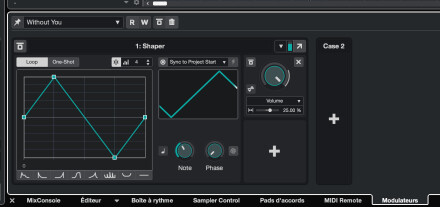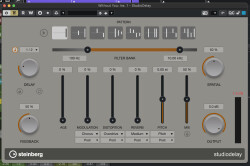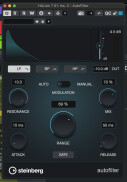It's almost Christmas, and Steinberg is doing its usual best to put a Cubase under the tree. What about this fourteenth version? Quite a lot, and especially quite a lot of creative stuff.

Cubase updates come and go, and they don’t resemble each other. Some focus more on audio, others on MIDI, and still others on productivity or ergonomics. So, what sauce do the wizards at Steinberg intend to serve us with the new version of their famous DAW? Well, it’s safe to say that this time around, the German developers have opted for creativity, with an orientation that should delight electro and hip-hop musicians, among others.
Modulato cantabile


.
In short, this is an excellent idea, all the more so as Steinberg has implemented it well ergonomically: it’s as simple to understand as it is to use, and it can prove extremely powerful with the possibility of combining several modulations via a macro knob, or even scripting complex modulations. This feature alone makes the update worthwhile, but it’s obviously not the only one. Steinberg also worked hard on the plug-in side.
New in the Branch In department…





But still…
Beyond the big new features, however, there are a thousand little things that are making progress or appearing here and there: a clip gain curve as we see with competitors, which makes quite a difference when it comes to editing and allows you to homogenize, for example, a vocal track without having to rely on a compressor and without playing scissors at every turn.
We’ll also note that we finally have tempo-synchronized pre-listening of Mediabay audio files, as well as DAWproject compatibility, click/drag track reorganization in the console, multi-assignment of external ports for effects or instruments, improved surround sound support (Dolby Atmos as well as Ambisonics) and 4K and 8K support for video. We’ll also mention the visual overhaul of the famous Control Room where we finally get a detailed CPU/RAM performance manager, allowing us to see what’s eating up resources and freeze accordingly.
As you can see, there’s plenty to satisfy more than one user on these micro-features often demanded by the community, bearing in mind that some of them are also innovative, such as the new option in the keyboard editor of assigning a playing probability for each note, which will make it possible to vary a pattern automatically. Last but not least, the score editor has been entirely redesigned based on the latest iteration of Dorico. At a time when Finale has hung up its gloves, this is no mean feat, even if you obviously won’t find here all the features of Steinberg’s score editor in its full version.
Overall, this fourteenth version is exciting in more ways than one, allowing Cubase to remain one of the most complete and attractive DAWs on the market. However, it would take much longer to list everything it contains than what it lacks. For example, there’s still no simple way to manage M/S in the software apart from a few plug-ins, while the ability to create Reason Combinator-style multi-instruments or multi-effects is still absent. The absence of real audio objects like those found in Samplitude must also be deplored… Finally, compared with the competition, we note that there’s still no Ableton Live-style matrix like in Logic, Digital Performer or Studio One, nor “ intelligent ” instruments or plug-ins like Logic now offers. Finally, we’re surprised that full-screen is still not supported on the Mac.


